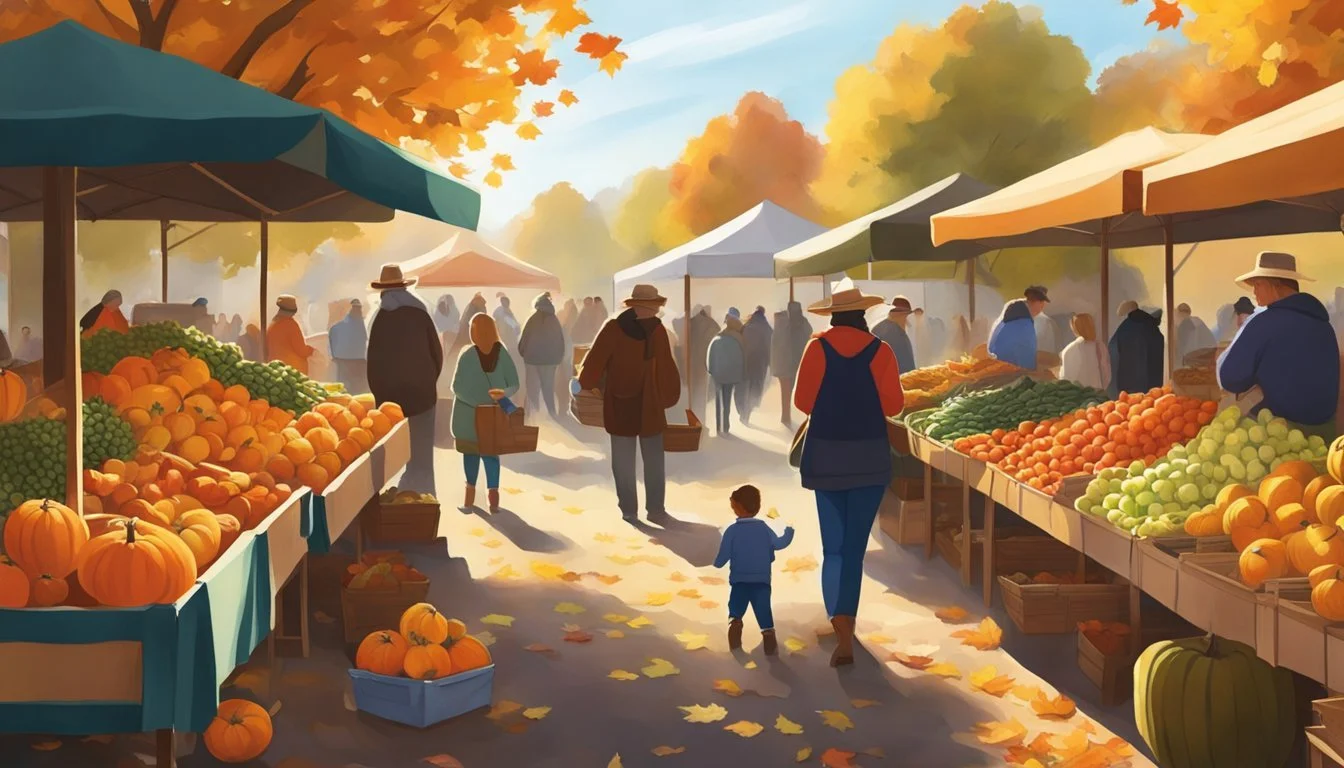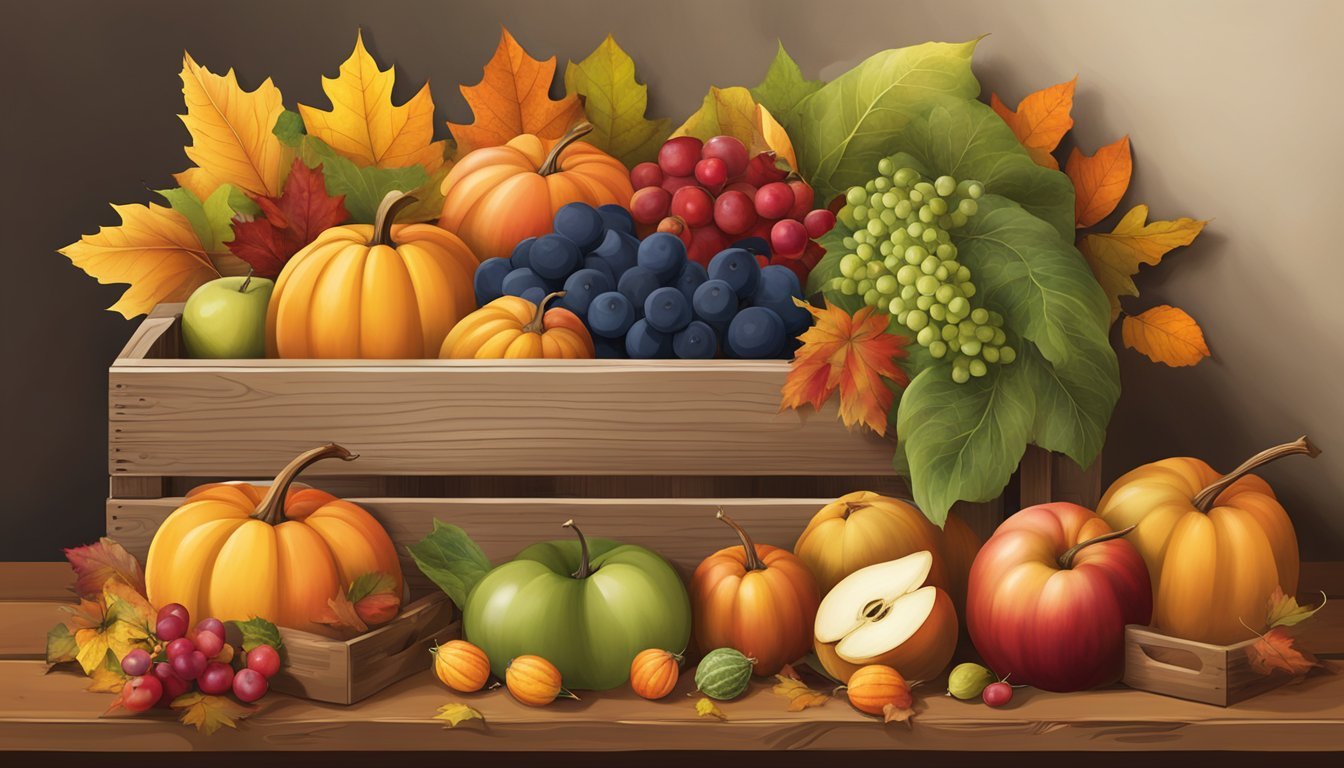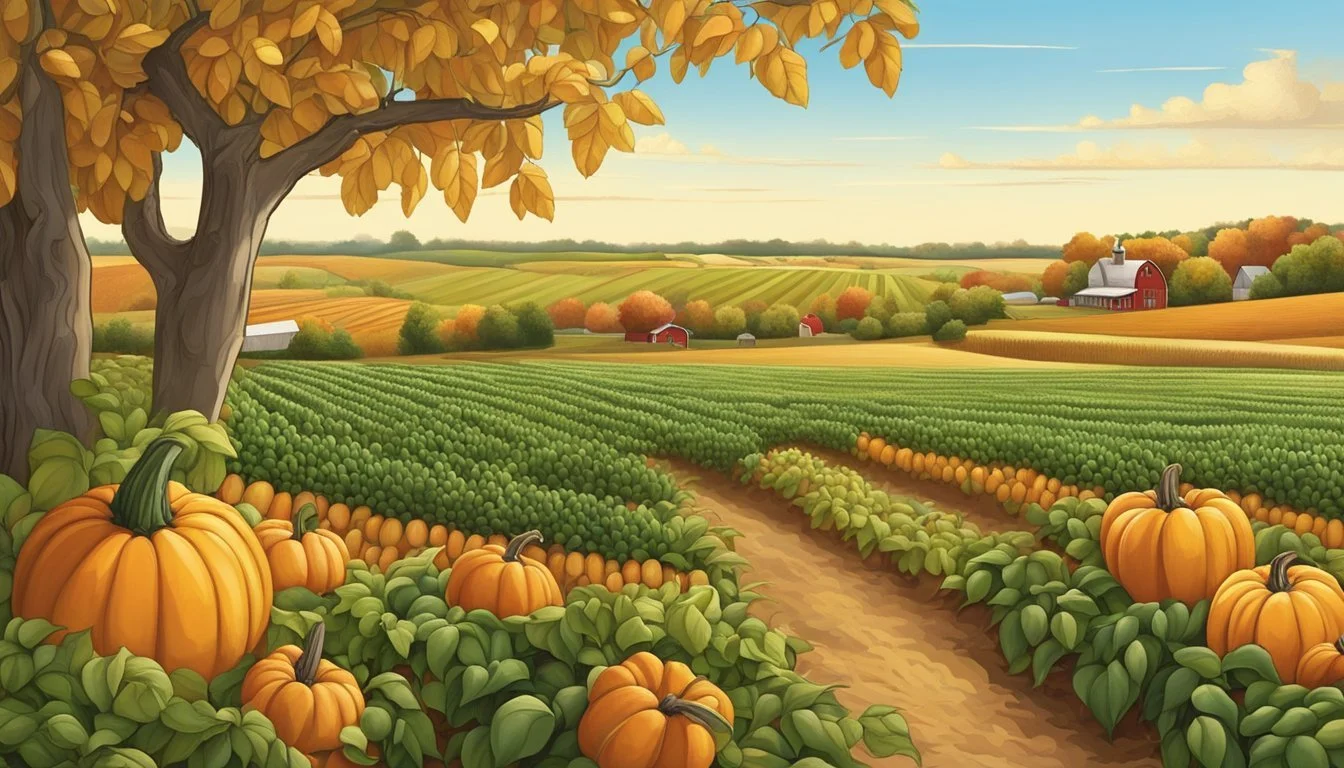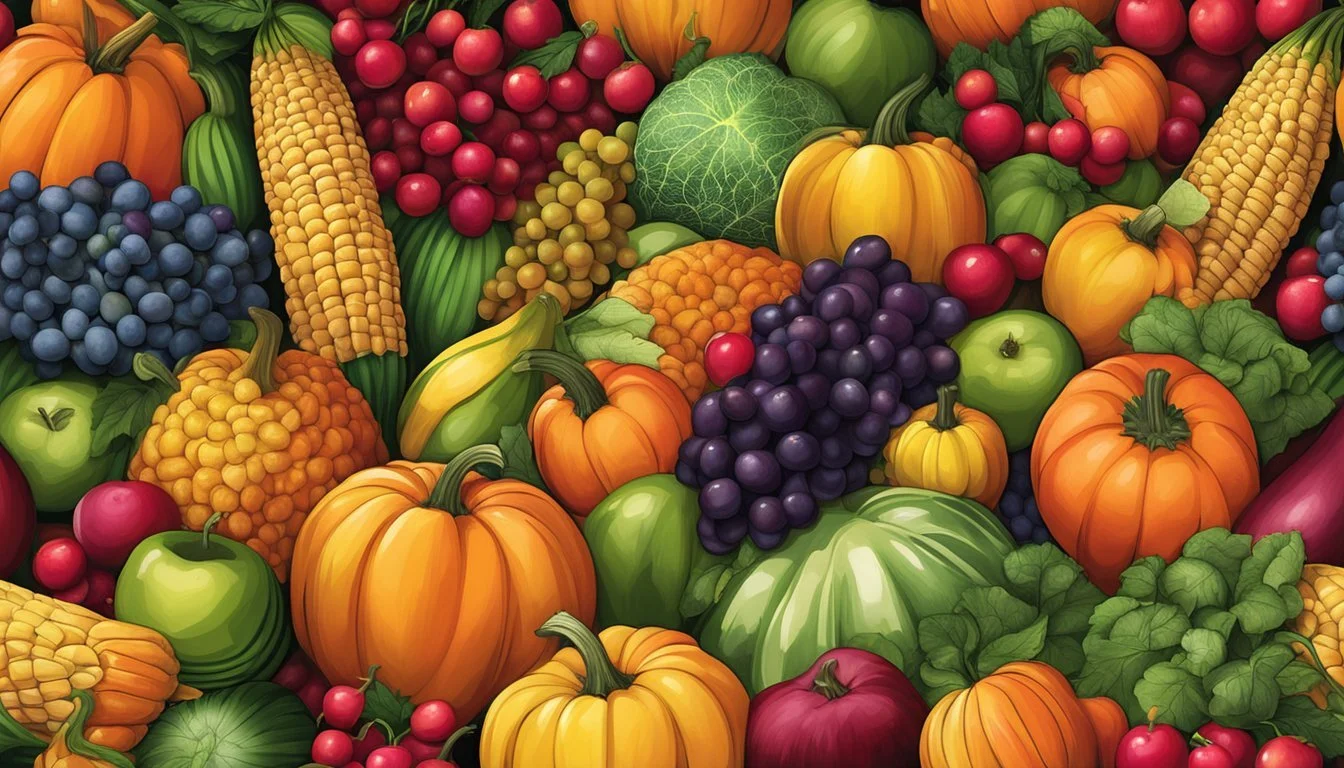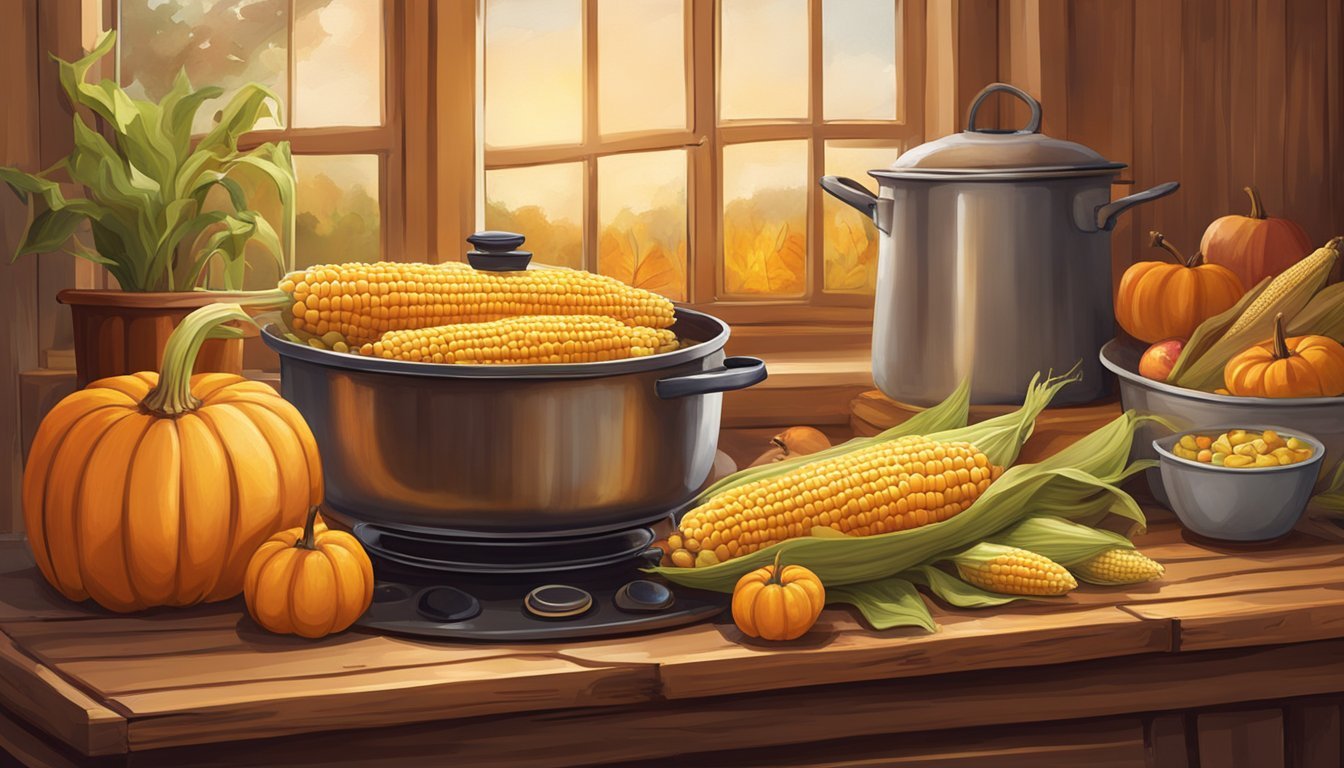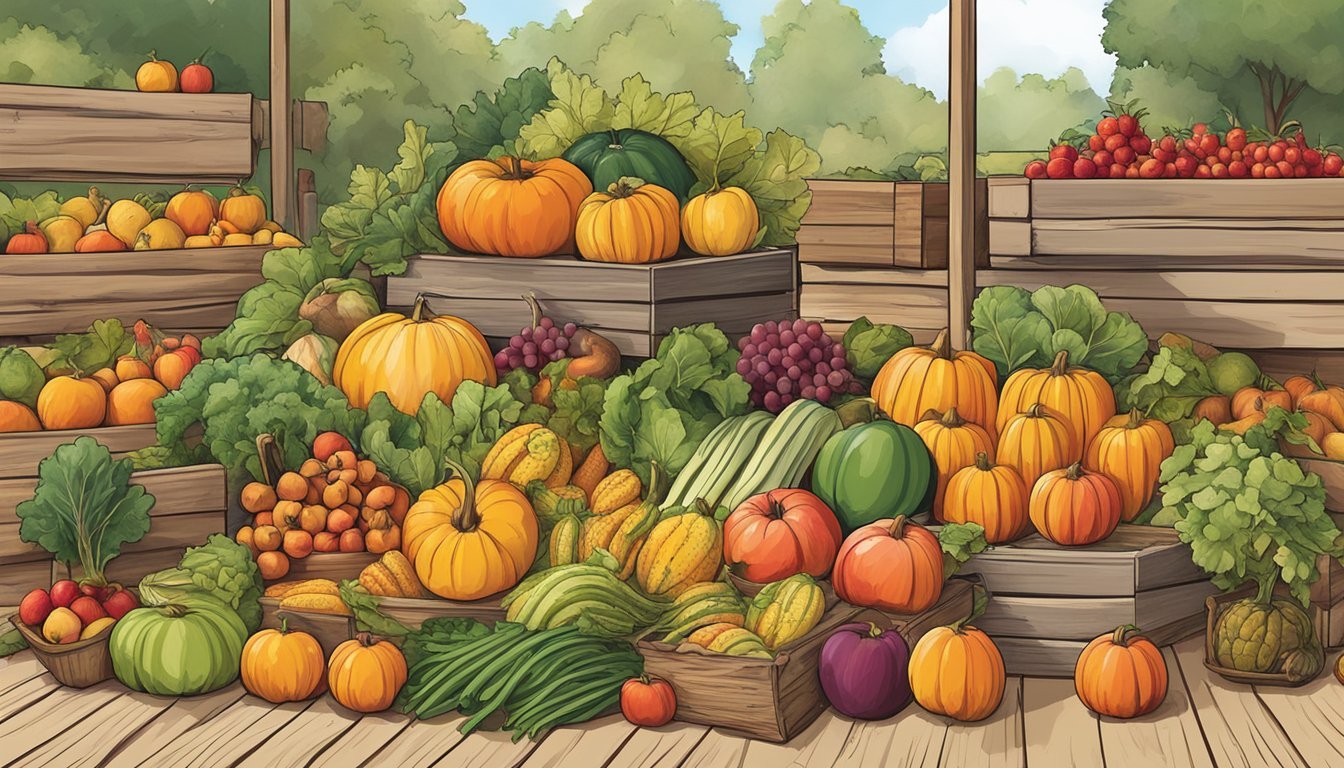Illinois Seasonal Fruit & Vegetables in November
A Guide to Local Produce
This Article is Part of our Illinois Seasonal Fruit & Veg Calendar
As the autumn leaves give way to the early signs of winter, November in Illinois marks a transitionary period for the agricultural calendar. During this month, the availability of fresh, locally grown produce shifts predominantly to hearty vegetables and a selection of robust late-season fruits. The fall harvest continues to deliver a variety of nutritious options that thrive in cooler temperatures, ensuring that even as the days grow shorter, the residents of Illinois can still enjoy a bounty of seasonal offerings.
Seasonal fruits that are typically harvested in Illinois through November include the last picks of apples (how long do apples last?) and pears, which have the resilience to withstand the falling temperatures. These fruits, having ripened throughout late summer and early fall, reach their peak flavor and are often used in a variety of holiday recipes. November also represents one of the last opportunities to savor these local fruits before the much leaner winter months commence.
Vegetables, on the other hand, are abundant. Root vegetables such as carrots (how long do carrots last?) and the uniquely flavored celeriac stay hardy and are often available fresh from the ground. Other cool-weather crops like Brussels sprouts (how long do brussels sprouts last?) and a variety of cabbages can still be found in the fields. These vegetables not only provide the foundation for warming, nutritious meals but also offer an array of health benefits during a time of year when wellness is particularly paramount.
Seasonal Fruit Highlights in November
As November arrives in Illinois, several fruits reach their peak, offering vibrant flavors and nutritional benefits perfect for both fresh consumption and culinary uses.
Apples
Illinois boasts a variety of apples still fresh and abundant in November. Tart varieties like Granny Smith are ideal for baking pies and making desserts, while sweeter options such as Red Delicious and Gala can be enjoyed raw or cooked.
Pears
Pears present a sweet and subtly floral note to the November selection. Varieties such as Bartlett and Anjou have a buttery texture and are versatile for both eating fresh and incorporating into desserts.
Persimmons
Persimmons come into season, with their unique flavor that can be described as a mix of honey and spice. They can be eaten fresh or used as a sweet addition to salads and desserts when fully ripe.
Pomegranates
Known for their jewel-like seeds, pomegranates offer a juicy burst of tart and sweet. They are typically in season and add a festive touch to dishes, as well as being a nutritious snack on their own.
Key Seasonal Vegetables in November
November marks a bountiful time for harvest in Illinois, characterized by a variety of robust vegetables suitable for hearty dishes. These include a range of squash varieties, essential root vegetables, and nutritious leafy greens that can be enjoyed roasted, in soups, or as side dishes.
Squash Varieties
In Illinois, November brings a rich assortment of squash, with pumpkin being a notable seasonal staple. Varieties such as butternut, acorn, and spaghetti squash are widely available, offering sweet and nutty flavors perfect for pies, soups, and casseroles.
Butternut Squash: Often mashed or pureed for soups.
Acorn Squash: Ideal for stuffing or roasting due to its shape and texture.
Spaghetti Squash: A unique variety that, when cooked, separates into strands similar to spaghetti.
Root Vegetables
Root vegetables thrive in November's cool climate, providing a sweet, deep flavor when roasted. Sweet potatoes (What wine goes well with sweet potatoes?) are particularly in season, boasting versatility in dishes ranging from savory mashed sides to sweet pies. Among others, carrots and beets also reach their peak, delivering concentrated flavors appreciated in various culinary preparations.
Sweet Potatoes: Can be baked, mashed, or used in soups.
Carrots: Excellent for roasting or as an addition to stews.
Beets: Offer a rich, earthy taste perfect for salads or as a roasted side dish.
Leafy Greens
The seasonal shift also sees leafy greens like kale and spinach remaining prolific, with these vegetables maintaining their vibrancy despite the colder weather. These greens are rich in nutrients and can be used fresh in salads or cooked to complement warm dishes.
Kale: Known for its sturdy texture, ideal for chips or sautéed as a side.
Spinach: A versatile green that wilts easily for warm salads or inclusion in pastas and soups.
Illinois' November vegetable selection offers a diverse palette for cooks to create comforting, nutritious meals during the fall season.
Illinois Farming Practices
Illinois farming practices reflect the state's commitment to providing a range of fresh produce to markets and stores, with a focus on sustainable and efficient harvest techniques and season-specific crop availability.
Harvest Techniques
Farms in Illinois prioritize innovative harvest techniques to ensure the quality and longevity of the produce. Mechanized harvesting is common among large-scale operations, particularly for grains and some vegetables, to maximize efficiency and minimize time between field and market. Smaller farms might employ hand-picking methods, especially for delicate fruits and vegetables that are susceptible to bruising, to maintain the integrity of the produce until it reaches the consumer.
Crop Availability
November Fruits: Due to the state's climate, fruit options in November are limited, with late-season varieties and stored produce generally available. Consumers can typically find:
Apples
Pears
November Vegetables: A wider variety of vegetables are harvested in Illinois during November. These include, but are not limited to:
Brussels Sprouts
Cabbage
Carrots
Cauliflower (how long does cauliflower last?)
Kale
Potatoes
Pumpkins
Squashes (such as butternut and acorn)
Sweet Potatoes
Turnips
These vegetables are often available at local farmers' markets and can be found in stores boasting fresh, locally grown produce. Farms may also offer community-supported agriculture (CSA) shares during this month, providing households with a variety of seasonal vegetables.
Benefits of Seasonal Eating
Eating seasonal produce in November in Illinois offers notable benefits. These include enhanced nutritional value, reduced environmental impact, and bolstered community support.
Nutritional Advantages
Seasonal fruits and vegetables are often more nutrient-dense because they are picked at their peak of ripeness. For example, Brussels sprouts and cabbage available in Illinois during November are likely to contain higher levels of vitamins and minerals. They also provide dietary fiber, which promotes digestive health.
Environmental Impact
The environmental impact is lessened when consuming produce that is in season locally. Seasonal consumption lowers the demand for out-of-season transport which can lead to reduced pollution and soil degradation. It also diminishes the need for extensive storage facilities, which can lead to energy savings.
Community Support
Purchasing seasonal produce supports local farming communities. It fosters a connection between consumer and grower and can stimulate the local economy. Additionally, it ensures the patronage of fresh produce markets, encouraging a sustainable food culture within the community.
Preparation and Cooking Ideas
November in Illinois brings a harvest rich in variety and flavor, providing ample opportunities for both traditional and innovative culinary creations. Cooking methods like roasting enhance the natural sweetness of root vegetables, while raw preparations let the freshness of late-season crops shine.
Roasting and Baking
Roasting root vegetables such as parsnips, turnips, and beets intensifies their natural sugars, making them a hearty side dish. A light coat of olive oil, salt, and herbs before placing them in the oven brings out a caramelization that is both sweet and savory.
Pumpkins and squash can also be roasted whole or in slices to create a rich, flavorful base for desserts or as part of a warm, inviting entrée.
Brussels sprouts achieve a crispy, charred exterior that pairs excellently with balsamic glaze or shaved Parmesan when roasted.
Salads and Raw Snacks
Raw preparations preserve the crisp texture and nutrients of vegetables, ideal for salads.
Shredded cabbage and thinly sliced celery root make for a crunchy, refreshing salad base.
Dressings using seasonal ingredients like cranberry sauce or apple cider add a unique twist to salads.
Cubed butternut squash can be roasted lightly and added to salads for a tender contrast.
Preserves and Sauces
Preserves and sauces capture the essence of the season's produce for use throughout the year.
Pumpkin can be pureed and mixed with spices to create a preserve that serves as the foundation for pies and spreads.
Fruits, such as cranberries, are perfect for making cranberry sauce or salsa that can accompany meats or be used as a tangy spread.
Squash can be simmered and blended into velvety soups or sauces, their versatility lending itself to both sweet and savory applications.
Getting the Most Out of Seasonal Purchases
This section provides practical advice for purchasing and storing Illinois's seasonal produce to ensure freshness and support local markets.
Storage Tips
Storing fresh produce correctly is crucial to maintain its quality. For example, Brussels sprouts and cabbage, which are in season, should be kept in a cold, moist environment, typically in the crisper drawer of a refrigerator. Carrots, another November staple, can last for several months if placed in a cool, dark place, like a root cellar, or they can be refrigerated. Cauliflower should be stored in the refrigerator with its head down to prevent moisture accumulation, which can lead to spoilage.
Peak Season Buying
Purchasing produce at its peak yields the best flavors and nutritional content. In November, shoppers can find Brussels sprouts, cabbage, carrots, and cauliflower at their best in Illinois. Consumers should look for firmness in Brussels sprouts and cabbage and avoid those with loose or yellowing leaves. Fresh carrots should be firm and bright in color, and cauliflower should have a tightly packed head with no dark spots.
Supporting Local Markets
When buying seasonal produce, choosing local markets and stores enhances the local economy and reduces carbon footprints due to shorter transportation distances. Customers can often meet the farmers and learn more about where their food comes from, which builds community and trust in the food system. Visiting farmers markets or subscribing to a CSA (Community Supported Agriculture) box is an excellent way for Illinois residents to obtain the freshest in-season produce and support local farmers.

